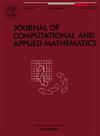Pricing of timer volatility-barrier options under Heston’s stochastic volatility model
IF 2.1
2区 数学
Q1 MATHEMATICS, APPLIED
Journal of Computational and Applied Mathematics
Pub Date : 2024-10-11
DOI:10.1016/j.cam.2024.116310
引用次数: 0
Abstract
Timer options are financial instruments that enable investors to exercise their rights on a random maturity date the realized variance reaches the level of variance budget. These options provide a stable investment opportunity for investors under the unpredictable and complex financial markets, such as global financial crisis or COVID-19 pandemic, which can induce the drastic changes of the volatility for the underlying asset. Meanwhile, in the financial markets, investors who invest in standard timer options may face the problems caused by the postponement of the exercising time for too low volatility, compared to standard vanilla options. In this regard, to overcome such disadvantages, we propose timer volatility-barrier options, which are activated and expired when the volatility arrives at a relatively low barrier level, with the original properties of the standard timer options. In this paper, by making use of the method of images, we derive an analytical formulas for the timer volatility-barrier options so that the volatility process can be driven by Heston stochastic volatility model, and verify the pricing accuracy of the timer options by comparing our solutions with those obtained from Monte Carlo simulations. Finally, we conduct numerical studies on the timer volatility-barrier options to examine the pricing sensitivities with respect to the various model parameters, and implement the discussion for pricing formula of double volatility barrier type of the timer options.
赫斯顿随机波动率模型下的定时波动率障碍期权定价
定时期权是一种金融工具,它使投资者能够在随机到期日行使其权利,即已实现的波动率 达到波动率预算水平。在全球金融危机、COVID-19 大流行等不可预测的复杂金融市场环境下,这些期权为投资者提供了一个稳定的投资机会。同时,在金融市场中,与标准虚值期权相比,投资标准定时期权的投资者可能会面临因波动率过低而推迟行权时间的问题。为此,为了克服这种弊端,我们提出了定时波动率障碍期权,当波动率到达一个相对较低的障碍水平时,该期权被激活并到期,同时具有标准定时期权的原有特性。本文利用图像法推导出了定时波动率-障碍期权的解析公式,使波动率过程可以由 Heston 随机波动率模型驱动,并通过将我们的解与蒙特卡罗模拟得到的解进行比较,验证了定时期权的定价准确性。最后,我们对定时波动率壁垒期权进行了数值研究,以检验定价对各种模型参数的敏感性,并对定时期权双波动率壁垒类型的定价公式进行了讨论。
本文章由计算机程序翻译,如有差异,请以英文原文为准。
求助全文
约1分钟内获得全文
求助全文
来源期刊
CiteScore
5.40
自引率
4.20%
发文量
437
审稿时长
3.0 months
期刊介绍:
The Journal of Computational and Applied Mathematics publishes original papers of high scientific value in all areas of computational and applied mathematics. The main interest of the Journal is in papers that describe and analyze new computational techniques for solving scientific or engineering problems. Also the improved analysis, including the effectiveness and applicability, of existing methods and algorithms is of importance. The computational efficiency (e.g. the convergence, stability, accuracy, ...) should be proved and illustrated by nontrivial numerical examples. Papers describing only variants of existing methods, without adding significant new computational properties are not of interest.
The audience consists of: applied mathematicians, numerical analysts, computational scientists and engineers.

 求助内容:
求助内容: 应助结果提醒方式:
应助结果提醒方式:


